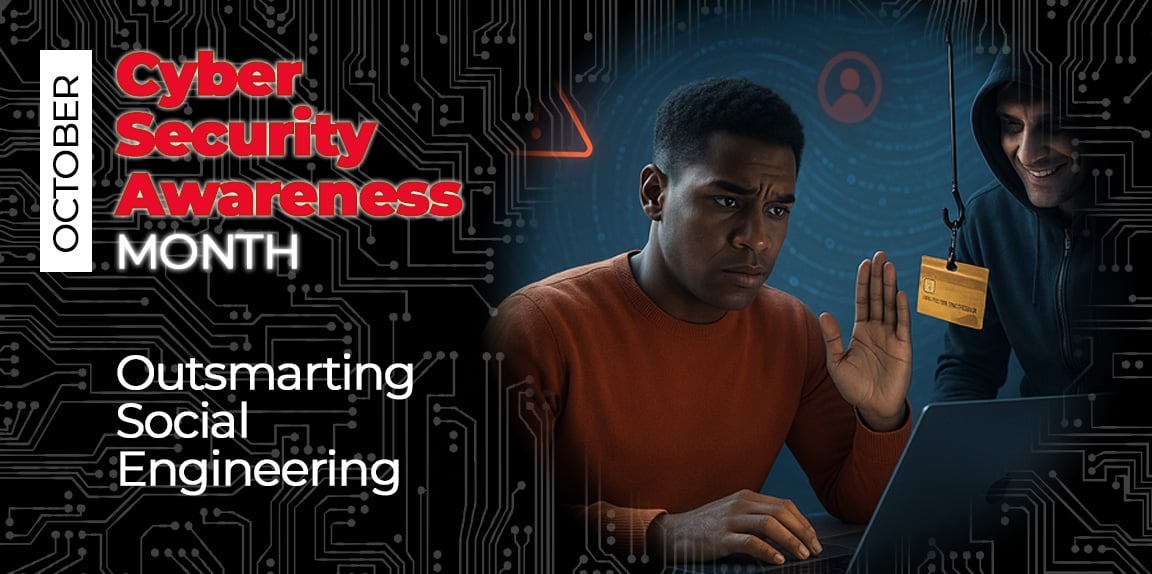Cybersecurity Awareness Month – Outsmarting Social Engineering
October 7, 2025 •Jason Dell

Cybercriminals don’t always need sophisticated malware or advanced hacking tools to break in. More often than not, they go after the weakest link: people. That’s what makes social engineering so dangerous — it’s about tricking someone into handing over the keys rather than picking the lock.
And it comes in many forms, often referred to as the “-ishings”:
- Phishing: Deceptive emails designed to steal logins or spread malware.
- Spear Phishing: Targeted attacks tailored to specific individuals or companies.
- Smishing: Text messages pushing fake links or urgent alerts.
- Vishing: Phone calls where attackers impersonate trusted contacts.
- Quishing: Malicious QR codes that send you to compromised websites.
- Clone Phishing: Look-alike versions of real emails with swapped links or attachments.
Why Social Engineering Works
Attackers exploit human psychology — urgency, trust, fear, or curiosity — because it’s often faster and easier than cracking a firewall or other security controls. The human element remains the top cybersecurity risk in most organizations.
How to Mitigate the Risk of Social Engineering
With the right mix of training and technology, you can significantly reduce your risk:
- Security Awareness Training: Teach employees how to spot suspicious emails, links, and requests. Training doesn’t have to be dry — gamifying it with quizzes, leaderboards, and rewards makes learning fun and more effective.
- Phishing Simulations: Test and reinforce good habits with realistic, safe simulations.
- Email Security: Stop threats before they reach inboxes with secure email gateways, impersonation detection, and advanced filtering.
- Web Security: DNS filtering and secure web gateways prevent users from accidentally landing on malicious sites.
- Multi-Factor Authentication (MFA): Adds a critical layer of protection when credentials are compromised.
- Zero-Trust Access Controls: Never assume trust; continuously verify users, devices, and requests.
- Incident Response Plans: Ensure employees know how to report and what to do when something looks suspicious.
Building Resilience
No single solution can stop social engineering. It takes people and technology working together — trained, engaged employees backed by strong security controls. When your workforce becomes an active part of your defense, you turn your biggest risk into a powerful shield.
Take Action
This Cybersecurity Awareness Month, strengthen your defenses against social engineering with the right technical safeguards. From advanced email filtering and web security to multi-factor authentication and zero-trust access controls, we can help ensure your organization is protected where it matters most.
Contact us today for a free consultation to review your security posture and identify the technical controls that will best protect your business.
Get Updates
Featured Articles
Categories
- AI (15)
- Automated Technology (8)
- backup (1)
- Cisco (26)
- Cisco Live Update (1)
- Cisco News (2)
- Cisco UCS (1)
- Cloud Networking (4)
- Collaboration (25)
- compute (1)
- CyberSecurity (29)
- Data Center (32)
- DevOps (3)
- DisasterRecovery (1)
- DNA (2)
- Education (3)
- Encryption (1)
- Enterprise Networking (31)
- Full-Stack (1)
- Future (1)
- healthcare (2)
- hybrid cloud (1)
- Innovative Technology (11)
- Internet of Things (2)
- IoT (1)
- Managed Services (10)
- Modern Data Center (2)
- Monitoring (1)
- Network Management (4)
- Networking (2)
- nutanix (1)
- Observability (1)
- Ransomware (2)
- SchoolTechnology (6)
- SD-WAN (1)
- SDN (1)
- securit (1)
- Security (68)
- security management (1)
- security strategy (6)
- SSE (1)
- sustainability (1)
- Telehealth (3)
- veeam (1)
- Video (1)
- Virtualization (2)
- webex (2)
- XDR (1)
- Zero Trust (8)


